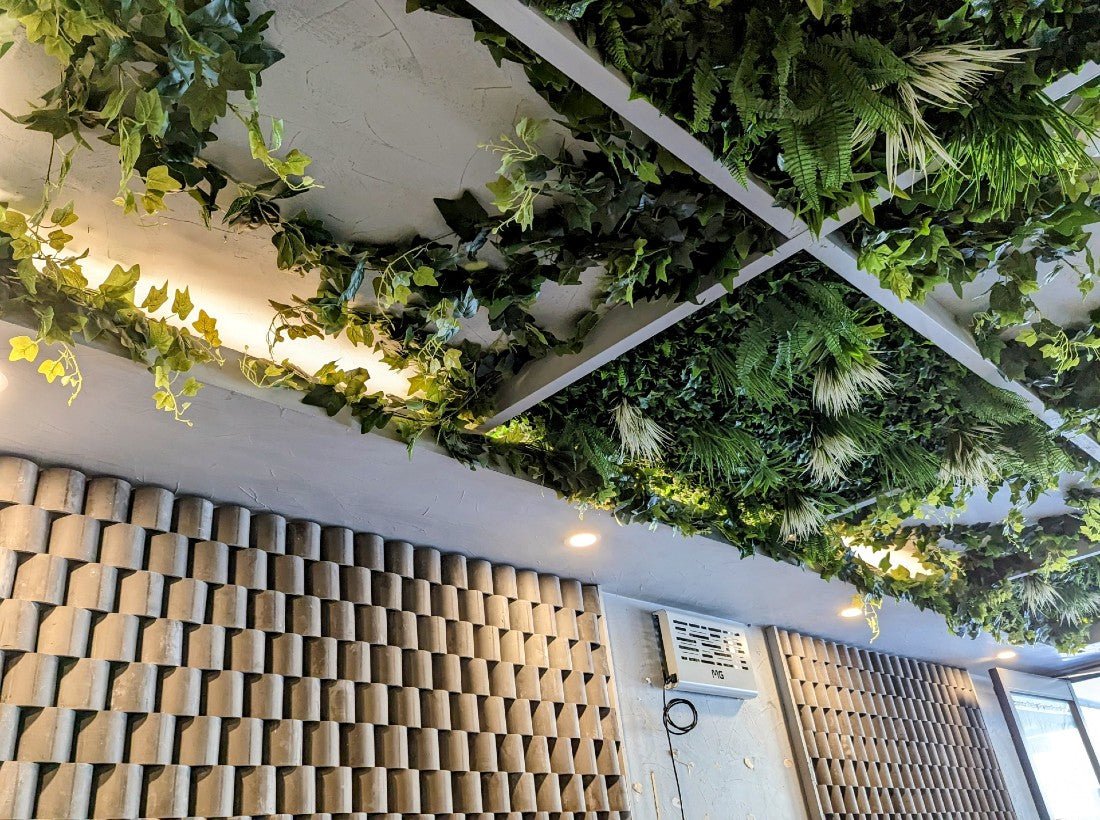You’ve got space screaming for a little greenery.
But you’re hesitant because the last time you tried keeping a plant alive, you barely made it past week two. And you don’t like seeing defeat so overtly.
So, you’ve cut your losses and decided to rest on your laurels. Now, you’re looking for convenience and easy maintenance to avoid disappointment. And you can find exactly that with artificial vines.
The only question is: how do you hang artificial vines on the ceiling without ending up in a tangled mess?
Luckily, you don’t need to be a DIY expert to come up with a creative application that mimics the floating gardens of Babylon. You just need a few trailing fake vines and a lot of enthusiasm (and patience).
Let’s talk about how you can get your decor to new heights.
How to Hang Artificial Vines on the Ceiling?
Creating a nature-inspired space with no upkeep won’t take you more than a day if you commit. Hanging your imitation ivy vines from the ceiling is a quick, easy, and pain-free way to start living among foliage.

Here’s how to make it happen:
Tools Needed
Before you begin the installation, you should have the following tools and materials in your inventory for preparation and execution:
- Hooks, clips, or adhesives
- Measuring tape
- Marking instruments
- Ladders or step stools
- Building blueprints
- Drills or screwdrivers
- Safety goggles
- Gloves
- Accessories
Step-by-Step Guide
Since artificial hanging plants are made with convenience in mind, they won’t cause you any trouble during installation. All you need to do is follow our step-by-step guide:
1. Choose your artificial ivy vines
Before you start, you need to choose your fake vines. With the plethora of options available today, this might be harder than it looks.
Decide whether you want to stick to one style of artificial vine for a uniform look or mix a few different types for variety. For example, you can install a string of artificial hanging pearls like our client Blok did. Or, you can have different lengths, leaf shapes, and shades to add dynamism, just like at the Magpies Waitara.
Sleep on it for a while but don’t stress it - the vines are artificial, so you can switch them out when you want something different.
2.Measure and mark the ceiling
Use a tape measure to gauge where you want your faux trailing plants to hang. Then, mark those spots with a pencil, marker, or chalk.
This is crucial if you want to avoid making mistakes before it’s too late. Plus, it will help you space your vines evenly and prevent awkward gaps or overcrowding. Like with many DIY projects, preparation is key, so don’t rush it.
We recommend finding another pair of eyes to look at your markings before you put your hooks in. Sometimes, other people can notice inconsistencies you couldn’t.
3. Select the right hooks
If you comb our collection of artificial hanging plants, you’ll notice they come unique qualities. Some artificial vines are heavier, others lighter.
Depending on the weight and style of your fake vines, you’ll need to choose appropriate hooks. You can secure lightweight vines with adhesive hooks, but heavier ones need sturdier hooks mounted into the ceiling.
And if you’re not a professional and don’t know the intricacies of your ceiling, check building blueprints or ask experts for advice. It’s always best to delay your project and be safe than to rush it and risk any ceiling cracks.
4. Create a grid-like pattern
When you first stand hanging, aim for a grid-like arrangement. The first few imitation ivy vines should tell you if you have even coverage across the ceiling. This way, you won’t have gaps that break the illusion of a fully vine-covered ceiling.
After you’ve established your grid, you can install other vines more messily in between. Or, you can add hanging baskets for a more visually arresting vista.
Play around with the placement of your artificial vine before you secure everything. This is the only way to make sure you’ll be 100% satisfied with the layout.
5. Add your accessories
Once the vines are in place, go crazy with the decoration. Or don’t, it’s up to you.
You can add lights, ornaments, or other decor like ribbons and bows. Alternatively, you can leave them as is and enjoy the green.
If you decide to accessorize, mind your decor’s weight - too many accessories can strain your hooks. In turn, this will cause the vines to sag and lose their lushness.
So, if you’re unsure, we’d say less is more.
Safety Precautions
Let’s get to the tedious (but crucial) part of the process: safety measures. .
Before you hang your artificial vines, be cautious. While these decorations are lightweight, improper installation or oversight can lead to damage - or worse, a safety hazard.
Here are key factors to keep in mind when prepping your ceiling:
- Weight distribution: Don’t put too much strain on any one spot of your ceiling to prevent sagging and reduce the risk of anything falling.
- Structural integrity: Check the strength of your ceiling before installation. If you can’t do this yourself, call a professional.
- Appropriate fasteners: Choose fasteners that can handle the load and are conducive to the weight of the vines.
- Appropriate installation: If you have the manufacturer’s instructions for fasteners and hooks, follow them rigidly. If not, do independent research before handling them.
- Nearby lighting: Exercise caution when placing vines near lights. Ensure that no parts of the vines come into contact with bulbs or heat sources that are a fire risk.
Which Artificial Vines Do You Choose?

Now that we’ve got the technicalities out of the way, let’s talk decor.
The type of faux trailing plants you choose can make a world of difference. And with so many options, the choice can quickly become cumbersome.
So, how do you decide which artificial vine will suit your space?
You follow the 3S:
Consider how much room you have to work with. Unfortunately, even if you’re head over heels for our artificial fern ball, if you don’t have the space for it, it’s going to look cramped.
Smaller spaces benefit from more delicate, subtle vines like the wispy faux bracken fern. On the other hand, larger rooms can handle more dramatic, fuller greenery like the hanging green wall discs.
In any case, if there’s not enough space to fit a plant, don’t force it. It’s better to leave some room for it to breathe than overdo it right off the bat.
The style of the artificial vine should match the appearance of your room. If you want a tropical look, you shouldn’t be looking at fake hanging plants that mimic those you’ll only find in the countryside.
Minimalist and modern spaces prefer thinner, straighter vines that keep things sleek. Alternatively, maximalist spaces do well with a myriad of different hanging plants, from faux flowers to baskets.
Imitation ivy vines come in various sizes and lengths. If you want them to drape, you need to think long. If you want them as part of a display, pick shorter vines with less imposing leaves.
Shorter ones are ideal for more contained looks, while longer ones can cascade and create that Pinterest-worthy curtain effect. In any case, you should determine if the length you like matches the height of your ceiling and your design vision.
Finishing Thoughts
So, now that you know how to hang artificial vines on a ceiling, what will you do with this information?
Don’t let this new knowledge fall by the wayside. With a little planning and attention to detail, you can make your room unrecognizable.
And the best part is - once it’s up, your greenery will keep looking fresh and vibrant with zero maintenance. You can just sit back and enjoy the view.
For bespoke advice or a custom artificial hanging plant, contact our team here.

